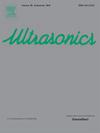用于大面积高精度在线无损检测的低频光纤光声换能器阵列
IF 3.8
2区 物理与天体物理
Q1 ACOUSTICS
引用次数: 0
摘要
在光纤光声(FO-OA)无损检测(NDT)中,扩大超声波检测范围仍然是大面积应用的关键挑战。而将检测范围扩展到更大的尺度则需要解决与超声强度和传播损耗相关的问题。近年来的研究主要集中在增强超声强度上,而通过降低超声传播损耗来进一步扩大检测范围的方法对超声无损检测具有重要意义。本研究在超声换能器中引入频率选择功能层,以有效降低超声频率。通过将聚乙烯(PE)颗粒掺入热膨胀材料中,形成增强高频成分衰减的功能层,将中心超声频率从1 MHz降低到0.3 MHz。该方法将平板结构的检测面积扩大到90 × 54 cm2。在单根光纤上制作了6元FO-OA传感器阵列,成功定位了样品上的所有缺陷,定位误差为0.894 cm。这些参数在测试配置的光声无损检测中显示了最先进的性能。研究表明,该方法有效地缓解了由于检测范围有限而导致的漏检问题。此外,在厚样品(30 × 30 × 1.5 cm3)上的测试也产生了0.781 cm的低定位误差,即使有多种超声传播模式,这表明PE颗粒的超声对多模态混叠具有优越的免疫力,为复杂介质提供了强大的解决方案。本文章由计算机程序翻译,如有差异,请以英文原文为准。
Low-frequency fiber-optic optoacoustic transducer arrays for large-area high-precision online non-destructive testing
In Fiber-optic optoacoustic (FO-OA) non-destructive testing (NDT), expanding the ultrasonic detection range remains a critical challenge for large-area applications. While extending the detection range to larger scales necessitates addressing issues related to ultrasound intensity and propagation losses. Recent efforts have focused on enhancing ultrasound intensity, while methods to further extend the detection range by reducing ultrasound propagation losses are highly significant for ultrasonic NDT. This study introduces a frequency-selective functional layer in ultrasound transducers to effectively lower the ultrasound frequency. By incorporating polyethylene (PE) particles into the thermally expandable material to form the functional layer that enhances the attenuation of high-frequency components, the central ultrasound frequency is reduced from 1 MHz to 0.3 MHz. This approach expanded the detection area of the flat plate structure to 90 × 54 cm2. A 6-element FO-OA transducer array was fabricated on a single optical fiber, enabling the successful localization of all defects on the specimen with a positioning error of <0.894 cm. These parameters demonstrate state-of-the-art performance in optoacoustic NDT for the tested configurations. This work demonstrates that the frequency reduction method effectively mitigates the missed detection issues arising from the limited inspection range. Further, testing on a thick specimen (30 × 30 × 1.5 cm3) also yielded a low positioning error of 0.781 cm, even with multiple ultrasound propagation modes, indicating that the ultrasound with PE particles offers superior immunity to multimodal aliasing, providing a robust solution for complex media.
求助全文
通过发布文献求助,成功后即可免费获取论文全文。
去求助
来源期刊

Ultrasonics
医学-核医学
CiteScore
7.60
自引率
19.00%
发文量
186
审稿时长
3.9 months
期刊介绍:
Ultrasonics is the only internationally established journal which covers the entire field of ultrasound research and technology and all its many applications. Ultrasonics contains a variety of sections to keep readers fully informed and up-to-date on the whole spectrum of research and development throughout the world. Ultrasonics publishes papers of exceptional quality and of relevance to both academia and industry. Manuscripts in which ultrasonics is a central issue and not simply an incidental tool or minor issue, are welcomed.
As well as top quality original research papers and review articles by world renowned experts, Ultrasonics also regularly features short communications, a calendar of forthcoming events and special issues dedicated to topical subjects.
 求助内容:
求助内容: 应助结果提醒方式:
应助结果提醒方式:


